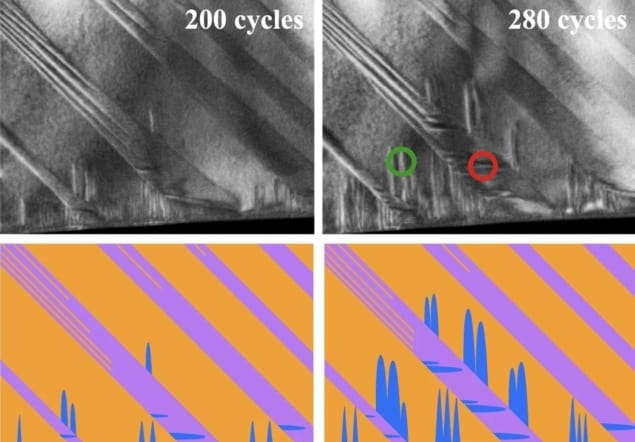
The first direct observation of the nanoscale degradation of a ferroelectric crystal has been made by researchers in Australia, China and the US. Qianwei Huang at the University of Sydney and colleagues used transmission electron microscopy (TEM) to discover how regions unresponsive to applied electric fields can build up at the domain walls of ferroelectric crystals, diminishing their performance. The discovery could lead to the design of nanoscale devices that are more resistant to the unwanted effects of ferroelectric degradation.
Ferroelectric materials have a spontaneous electric polarization, the direction of which can be reversed by applying an electric field. This useful property is widely used in electronic devices such as capacitors, sensors, actuators, and memories. One important challenge facing device designers is that after many cycles of electric field application, the ferroelectric nature of a materials can diminish steadily.
Known as ferroelectric degradation, this process can both reduce the reliability and shorten the lifespans of many electrical devices. Currently, it is widely believed that the effect is driven by build-ups of excess charge as they are injected into ferroelectric materials by external electrodes. So far, however, the nanoscale mechanisms behind this unwanted phenomenon have remained poorly understood.
Diffraction patterns
Now, Huang’s team used an advanced form of TEM to acquire the diffraction patterns displayed by electron beams as they passed through thin sheets of ferroelectric crystal. The material they used contained alternating domains of perpendicular polarization directions, arranged in a striped pattern. For the first time, this setup allowed researchers to make real-time, nanoscale observations of evolving ferroelectric degradation, over successive exposures to electric fields – which they applied parallel to the plane of the sheet.

Ferroelectricity: 100 years on
The team’s measurements revealed that charge distributions within the crystal gradually shifted during each cyclic application of an electric field. Over time, charges increasingly accumulated at the interfaces between the striped domains, from which a new domain developed and grew. Crucially, the polarization of this domain was no longer parallel to crystal sheet, making the material less responsive to applied electric fields. This result was the first direct observation of ferroelectric degradation, and strengthens our understanding of how the process unfolds on the molecular scale.
Since ferroelectric degradation is one of the most significant factors responsible for shortening lifespans of electrical devices, the discovery could enable researchers to better understand device failure mechanisms. In turn, this knowledge could lead to the design of materials that are more resistant to these effects. If achieved, this could lead to nanoscale devices capable of operating over more successive cycles of electric loading, improving the efficiency of the many systems that depend on them.
The research is described in Nature Communications



